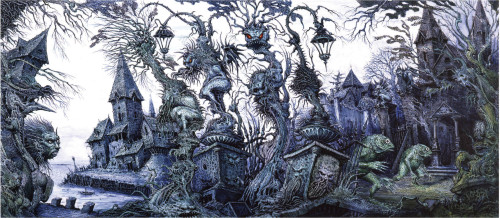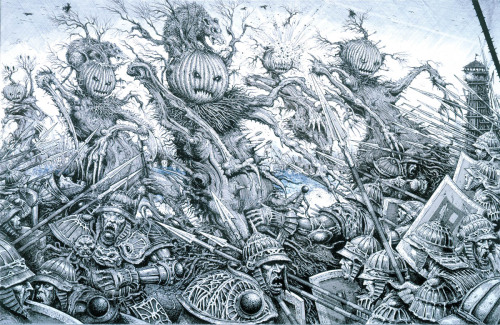
I've been a fan of Ian Miller's art since I first saw the cover for Ray Bradbury's anthology, Long After Midnight as a kid. My copy of that anthology had pride of place on my nightstand through my entire adolescence thanks to that cover.
Even if you don't recognize the name, you'll recognize the art. Ian Miller is a British fantasy illustrator with a very dark, very distinctive style. His career has spanned forty years, but he's best known for his contributions to David Day's Tolkien-inspired compendiums and a long run of cover art for some of the biggest names in genre.
When I saw that Ian Miller was releasing a book this year, I took a chance and requested an interview through his publisher, and I'm happy to report that I received his reply this morning.
Even if you don't recognize the name, you'll recognize the art. Ian Miller is a British fantasy illustrator with a very dark, very distinctive style. His career has spanned forty years, but he's best known for his contributions to David Day's Tolkien-inspired compendiums and a long run of cover art for some of the biggest names in genre.
When I saw that Ian Miller was releasing a book this year, I took a chance and requested an interview through his publisher, and I'm happy to report that I received his reply this morning.
Geek Art Gallery: April 15th, Titan Books released your latest collection, a book entitled The Art of Ian Miller. The book includes over three hundred illustrations spanning over four decades of your work. The first question that came to mind as I was paging through my copy was, how in the world did you decide what to include in this book?
Ian Miller: It was a very easy process. I sent a mountain of imagery to Beth Lewis, my editor, at Titan, and said pick the ones you like best. With the help of Natalie Clay the designer they came back with a book plan and those picture they thought did the job. I went through the selection, substituting images I thought worked better, or I liked more. For the most part the original selection worked really well. Natalie adjusted the layouts with the changes and it was in the bag. Titan have some very clever people working for them. I should not of course, forget to mention Laura Price, who started it all off at Titan, or Alison Eldred for suggesting a book of my work in the first place. Thank you all.
Geek Art Gallery: What would you consider to be your favorite piece from this collection?
Ian Miller: Difficult question. 'Favourite' is often driven by mood. On any given day, one favours different images. For the most part I see the shortfalls rather than the plus aspects of my imagery. Today My favourite image is/are the sections from Actium on pages 158– 159.
Geek Art Gallery: Over the years, you've illustrated some of my all-time favorite authors, including Bradbury, Herbert, Lovecraft, Poe, and Tolkien. Whose fiction did you most enjoy working on?
Ian Miller: Don't forget Mervyn Peake and Gormenghast. He is a great favourite of mine, and I'm still trying to draw Gormenghast castle properly after six or more attempts. Lovecraft flows well. Shadows, hidden places, and scuffling behind the wainscot have always appealed to me. As a child I would always make sure the toilet seat and cover were down at night in case something crept up and out into the house whilst everybody was asleep. Thinking back, I suppose I should have placed an anchor chain on top of the closed seat lid, but such things were rare in bathrooms when I was a child. 'Something Wicked this Way Comes' was my favourite Bradbury story, and is still is. Poe and Tolkien are gainsaid. I have never found drawing easy, but both these authors offered a rich seam to chip away at.
Geek Art Gallery: Is there an author whose work you haven't had an opportunity to illustrate that you would like a chance at?
Ian Miller: I'm sure there is. Whilst I read widely, there is always something or somebody new to discover. and I'm always open to suggestions. After that, it is whether I have the skill base and understanding to do the material justice.
I like the idea of free interpretation these days, rather than slavish adherence to the story line. I think this sometimes hamstrings the visual process. The image becomes a lame appendage, something stillborn and marginal. A good illustration, or piece of applied artwork, should both enrich the dedicated text and stand alone in its own right.
Geek Art Gallery: While preparing for this interview, I read quite a bit about your work, but no two articles could quite agree on what adjective to use to describe your signature style, though "dark" and "nightmarish" did pop-up with some frequency. How would you desribe your style to someone who hadn't seen any of your work before?
Ian Miller: I'm not sure I can. I hate labels, always have. Rather than assist in defining a person or process, they usually do nothing more than obstruct and confound the issue. "I'm a this!– your a that!– what could we possibly have in common?" People see what they wish to see. I have a wide remit image wise. There are racks and rolls of paper, of artworks no one has seen, or would readily associate with me. These would require another label, more amongst many.
Geek Art Gallery: Tell us a little bit about your background as an artist. I know that you studied Painting at St Martin’s in London, but I'm curious as to how you chose to go into art in the first place and where your career began once you'd finished with school.
Ian Miller: I wanted to be a soldier like my brother. My mother, who had a background in the theatre, was determined I would do something 'nice' 'safe' and creative. Truth to say, I don't think I needed much pushing, as I seemed to be bugger all use, at anything but drawing and painting. There was the twitch of course, but that was seasonal affair and another story. 'Highly strung' was a word my mother used a lot. I did think about a career on the Trapeze for a little while, even sword swallowing, but magic colouring books and coloured pencils lead me down another path. After the coloured pencils wore out it was large paint brushes and powder paint. One thing led to another, and I ended up doing a seven year stint at Art school. I was a slow learner but eventually the penny dropped and here I am.
I fell into illustration work by chance, after getting my degree. Most of my student friends went off to do a teaching course, or joined a night security company, so they could paint in the day. Most of them were too tired to paint after a long night shift patrolling a factory, though they all tried very hard, before giving it up. After seven years inside the system another year doing a teaching diploma was not an option. Illustration offered a compromise route and it appeared to pay. I did very well at the start but the enthusiasm waned after a year or two and I drifted away. The rest is history. There was a lot of fog and clanging bells. I remember that?
Geek Art Gallery: Do you have any advice for young artists just embarking on their careers?
Ian Miller: It can be a tough road to tread. Decide early on, whether you wish to follow, or lead, and act accordingly. Learn your craft, master the basics. There are lots of 'hot house blooms' about, with no sustainable root system / knowledge base. There is magic in the process, but it is only got in my experience by damned hard work. In short you have to sweat for it. When things go wrong, and they will, fall over, bite the floor, scream, cry, then get up and go again. If you can't do that find another job. Be generous and kind to your fellow artists. Humility is a virtue. If you are good at what you do, you do not need to brag or bore your fellows. Let the work speak for you. The prime directive is the pursuit of excellence. Good luck .
Geek Art Gallery: What is your artistic process like? Are you the kind of artist who works better with a firm objective and a looming deadline or the sort who works best by way of daydream?
Ian Miller: If you wait for a tap on the shoulder from the heavenly Muses, you might be waiting for a hell of a long time. There has to be a cognitive process in place even if not wholly defined. The 'Here' and 'Somewhere 'you have to get. The imperative is to move.
It is a crunch and grind process no matter how transient and fleeting it might sometimes seem. Whilst I have never missed an agreed deadline I do not much like them, and I do not work better for being pressed.
Geek Art Gallery: How has your artistic process changed over the past forty years? Have advances in computer technology changed the way you work, or do you prefer to work in more traditional mediums?
Ian Miller: I enjoy both the traditional methods of image making and the astonishing virtuosity of the commuter tool. I combine them on a regular basis. I do not have a problem with either. Needs must. A well construct image, is a well constructed image, no matter how it is achieved. A sound knowledge base adds subtly to the process.
I was told by one of my painting lectures at Art school that: "The technician stops were the artist begins" I think that is for the most part true.
Geek Art Gallery: What about the industry as a whole? How has the industry evolved over the course of your career? Do you think professional illustrators are better or worse off than they were prior to the mainstreaming of personal computers?
Ian Miller: It has certainly evolved., and it is certainly different, but I'm not sure I can really comment in any meaningful way as to whether it is better or worse. I think it’s a nonsense to keep blaming everything on computers. They are of course 'sweat shop fast,' but at days end, they are nothing more than a creative tool, and never better than the people who operate them. The lowest common denominator, is a product of the market place and profit ethos.
Geek Art Gallery: Finally, for all of your fans in our readership, I have to ask. What's next for you? Are there any projects or appearances looming on the horizon that we should be looking forward to?
Ian Miller: I have a another book just out called the Broken Diary, all words I'm afraid bar the cover, and available from Onerios Books.
I'm also adapting a script from a theatre project I wrote several years back called the Shingle Dance , reworking it for an animated film project with Stijn Windig a very clever Dutch artist and animator.
Private commissions are in hand and I'm writing things down again as I go.



No comments:
Post a Comment